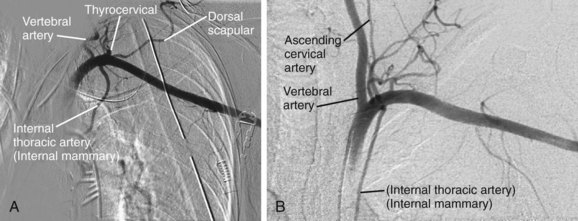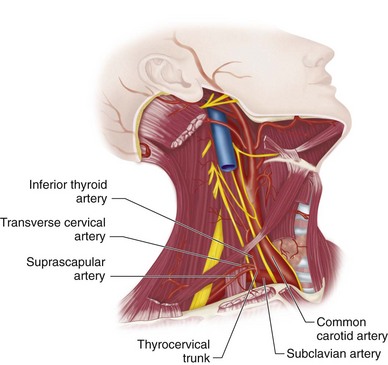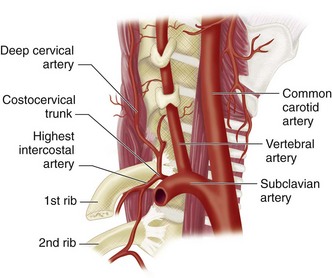CHAPTER 74 Arterial Anatomy of the Upper Extremities
NORMAL ANATOMY OF THE SUBCLAVIAN ARTERY
General Anatomic Descriptions
The subclavian artery arises from the brachiocephalic trunk (innominate artery) on the right and from the aorta on the left. It runs within the thoracic cage to the first rib, where it becomes superficial to the bony thorax and becomes the axillary artery. It gives rise to the vertebral artery, the internal thoracic artery (internal mammary artery), and the thyrocervical and costocervical trunks. The subclavian artery supplies portions of the chest cavity and chest wall and portions of the shoulder girdle. Ascending branches off the subclavian artery supply portions of the anterior neck, spinal cord, and brain (Fig. 74-1).
The vertebral artery is the first branch of the subclavian artery. The thyrocervical trunk and internal thoracic artery arise opposite each other from the anterosuperior and anteroinferior aspect of the subclavian artery. The thyrocervical trunk divides into the inferior thyroid artery with its characteristic looping course, the transverse cervical artery and the suprascapular artery (Fig. 74-2). It supplies the anterior neck, including the thyroid gland and the superior portion of the esophagus, as well as portions of the shoulder. The internal thoracic artery travels slightly anterior and inferiorly, deep to the thorax, to supply the rib cage and portions of the mediastinum. Inferiorly, it continues as the superior epigastric artery and anastomoses with the inferior epigastric artery in the anterior abdominal wall. The costocervical trunk arises distal to the thyrocervical trunk from the posterosuperior aspect of the subclavian artery. It divides into the deep cervical artery and supreme intercostal artery (highest intercostal artery) to supply the first two or three intercostal spaces and the deep structures of the neck (Fig. 74-3).
The first part of the axillary artery, from the first rib to the medial border of the pectoralis minor muscle, gives rise to the superior thoracic artery, also called the highest thoracic artery. It supplies the chest wall (Fig. 74-4).
The second part of the axillary artery, posterior to the pectoralis minor muscle, gives rise to the thoracoacromial artery and lateral thoracic artery, which supply the shoulder, anterior axilla, and chest wall (see Fig. 74-4). The thoracoacromial artery pierces the overlying costocoracoid membrane anteriorly, dividing into pectoral, acromial, clavicular and deltoid branches. The lateral thoracic artery courses inferiorly to anastomose with the internal thoracic, subscapular, and intercostal arteries, along with pectoral branches of the thoracoacromial artery. It supplies lateral mammary branches in women and is also called the external mammary artery.
The third part of the axillary artery extends laterally from the outer border of the pectoralis minor muscle to the lower border of the teres major muscle and gives rise to three branches, the subscapular artery and the anterior and posterior circumflex humeral arteries, which supply the posterior and lateral axilla (see Fig. 74-4). The subscapular artery divides into the circumflex scapular artery, the infrascapular artery (largest branch), and the dorsal thoracic artery. These branches anastomose with the lateral thoracic artery, intercostal arteries, and the deep branch of the transverse cervical artery. The anterior and posterior circumflex humeral arteries pass around the surgical neck of the humerus. The posterior circumflex humeral artery is the larger of the two.
Detailed Description of Specific Areas
Differential Considerations
Thoracic Outlet Syndrome
The thoracic outlet can pose hazardous areas of narrowing for arteries, veins, and nerves. The subclavian and axillary arteries are subject to compression at several narrow spaces along their course out of the thorax. The most common sites are the interscalene triangle, costoclavicular space, and subcoracoid space (Fig. 74-5
Stay updated, free articles. Join our Telegram channel

Full access? Get Clinical Tree




 FIGURE 74-1
FIGURE 74-1
 FIGURE 74-2
FIGURE 74-2
 FIGURE 74-3
FIGURE 74-3
 FIGURE 74-4
FIGURE 74-4